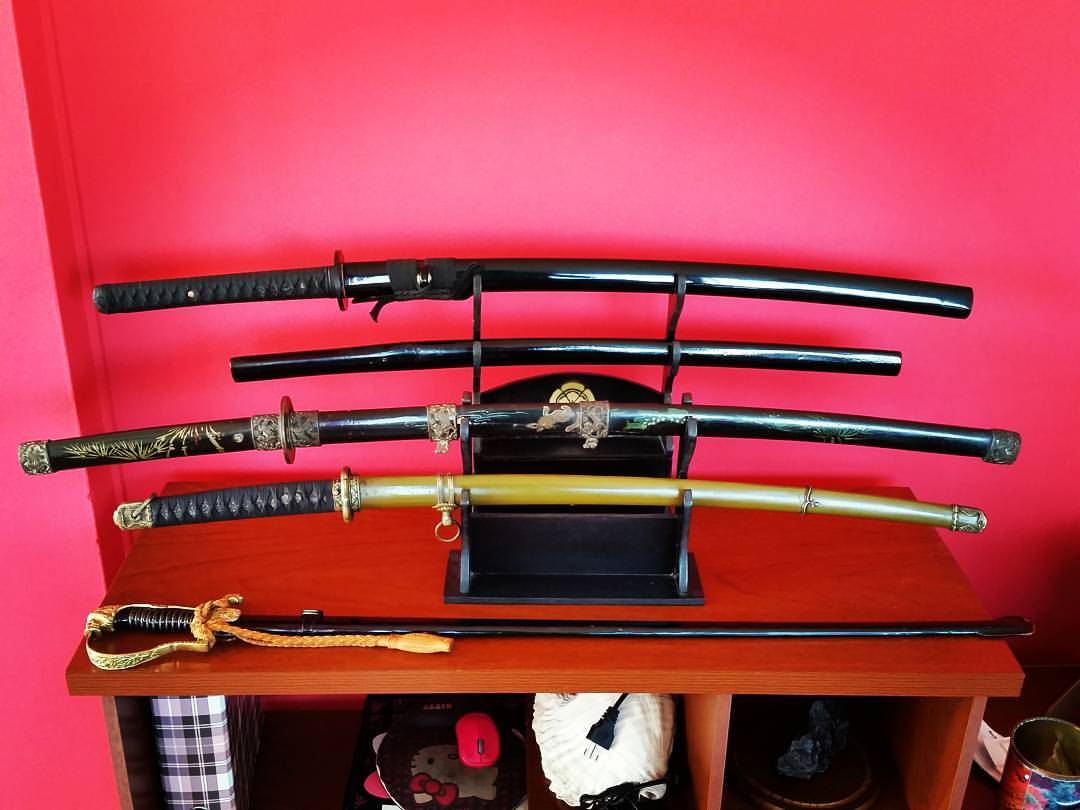By lyuesword | 23 September 2020 | 1 Comments
History of Japanese Samurai Sword KATANA
History of Japanese Katana Sword
The production of swords in Japan is divided into specific time periods:
* Jōkotō [ancient swords, until around 900]
* Kotō [old swords from around 900–1596]
* Shintō [new swords 1596–1780]
* Shinshintō [newer swords 1781–1876]
* Gendaitō [modern swords 1876–1945]
* Shinsakutō [newly made swords 1953–present]

The first use of katana as a word to describe a long sword that was different from a tachi occurs as early as the Kamakura Period [1185–1333]. These references to "uchigatana" and "tsubagatana" seem to indicate a different style of sword, possibly a less costly sword for lower-ranking warriors.
The evolution of the tachi into what would become the katana seems to have continued during the early Muromachi period [1337 to 1573]. Starting around the year 1400, long swords signed with the katana-style mei were made. This was in response to samurai wearing their tachi in what is now called "katana style" (cutting edge up).
Japanese swords are traditionally worn with the mei facing away from the wearer. When a tachi was worn in the style of a katana, with the cutting edge up, the tachi's signature would be facing the wrong way. The fact that swordsmiths started signing swords with a katana signature shows that some samurai of that time period had started wearing their swords in a different manner.

Katana took over from tachi and became popular among samurai because the battles in Japan gradually changed from individual cavalry battles to close-up battles in which large groups fought on foot, and Katana clearly became mainstream in the late Muromachi period. Around this time katana-forging also developed into a highly intricate and well-respected art form. Lacquered saya (scabbards), beautifully engraved fittings, silk handles and elegant tsuba were all the rage among samurai in the Edo Period, and eventually (especially when Japan was in peace time), katana became more cosmetic and ceremonial items than practical weapons.
The quicker draw of the sword was well suited to combat where victory depended heavily on short response times. The katana further facilitated this by being worn thrust through a belt-like sash (obi) with the sharpened edge facing up. Ideally, samurai could draw the sword and strike the enemy in a single motion. Previously, the curved tachi had been worn with the edge of the blade facing down and suspended from a belt.
The length of the katana blade varied considerably during the course of its history. In the late 14th and early 15th centuries, katana blades tended to have lengths between 70 and 73 centimetres (27 1⁄2 and 28 3⁄4 in). During the early 16th century, the average length dropped about 10 centimetres (4 in), approaching closer to 60 centimetres (23 1⁄2 in). By the late 16th century, the average length had increased again by about 13 centimetres (5 in), returning to approximately 73 centimetres (28 3⁄4 in).

The katana was often paired with a smaller companion sword, such as a wakizashi, or it could also be worn with a tantō, a smaller, similarly shaped dagger. The pairing of a katana with a smaller sword is called the daishō. Only samurai could wear the daishō: it represented their social power and personal honor.
Want a unique sword? Feel free to contact us:
Email: lyuesword@hotmail.com
Website: www.lyuesword.com
Custom Sword Page: www.lyuesword.com/Custom-Sword/customization-options/Create-Your-Own-Swords
The production of swords in Japan is divided into specific time periods:
* Jōkotō [ancient swords, until around 900]
* Kotō [old swords from around 900–1596]
* Shintō [new swords 1596–1780]
* Shinshintō [newer swords 1781–1876]
* Gendaitō [modern swords 1876–1945]
* Shinsakutō [newly made swords 1953–present]

The first use of katana as a word to describe a long sword that was different from a tachi occurs as early as the Kamakura Period [1185–1333]. These references to "uchigatana" and "tsubagatana" seem to indicate a different style of sword, possibly a less costly sword for lower-ranking warriors.
The evolution of the tachi into what would become the katana seems to have continued during the early Muromachi period [1337 to 1573]. Starting around the year 1400, long swords signed with the katana-style mei were made. This was in response to samurai wearing their tachi in what is now called "katana style" (cutting edge up).
Japanese swords are traditionally worn with the mei facing away from the wearer. When a tachi was worn in the style of a katana, with the cutting edge up, the tachi's signature would be facing the wrong way. The fact that swordsmiths started signing swords with a katana signature shows that some samurai of that time period had started wearing their swords in a different manner.

Katana took over from tachi and became popular among samurai because the battles in Japan gradually changed from individual cavalry battles to close-up battles in which large groups fought on foot, and Katana clearly became mainstream in the late Muromachi period. Around this time katana-forging also developed into a highly intricate and well-respected art form. Lacquered saya (scabbards), beautifully engraved fittings, silk handles and elegant tsuba were all the rage among samurai in the Edo Period, and eventually (especially when Japan was in peace time), katana became more cosmetic and ceremonial items than practical weapons.
The quicker draw of the sword was well suited to combat where victory depended heavily on short response times. The katana further facilitated this by being worn thrust through a belt-like sash (obi) with the sharpened edge facing up. Ideally, samurai could draw the sword and strike the enemy in a single motion. Previously, the curved tachi had been worn with the edge of the blade facing down and suspended from a belt.
The length of the katana blade varied considerably during the course of its history. In the late 14th and early 15th centuries, katana blades tended to have lengths between 70 and 73 centimetres (27 1⁄2 and 28 3⁄4 in). During the early 16th century, the average length dropped about 10 centimetres (4 in), approaching closer to 60 centimetres (23 1⁄2 in). By the late 16th century, the average length had increased again by about 13 centimetres (5 in), returning to approximately 73 centimetres (28 3⁄4 in).

The katana was often paired with a smaller companion sword, such as a wakizashi, or it could also be worn with a tantō, a smaller, similarly shaped dagger. The pairing of a katana with a smaller sword is called the daishō. Only samurai could wear the daishō: it represented their social power and personal honor.
Want a unique sword? Feel free to contact us:
Email: lyuesword@hotmail.com
Website: www.lyuesword.com
Custom Sword Page: www.lyuesword.com/Custom-Sword/customization-options/Create-Your-Own-Swords
Recently Reviews
Read MoreLeave a Reply
Your email address will not be published.Required fields are marked. *